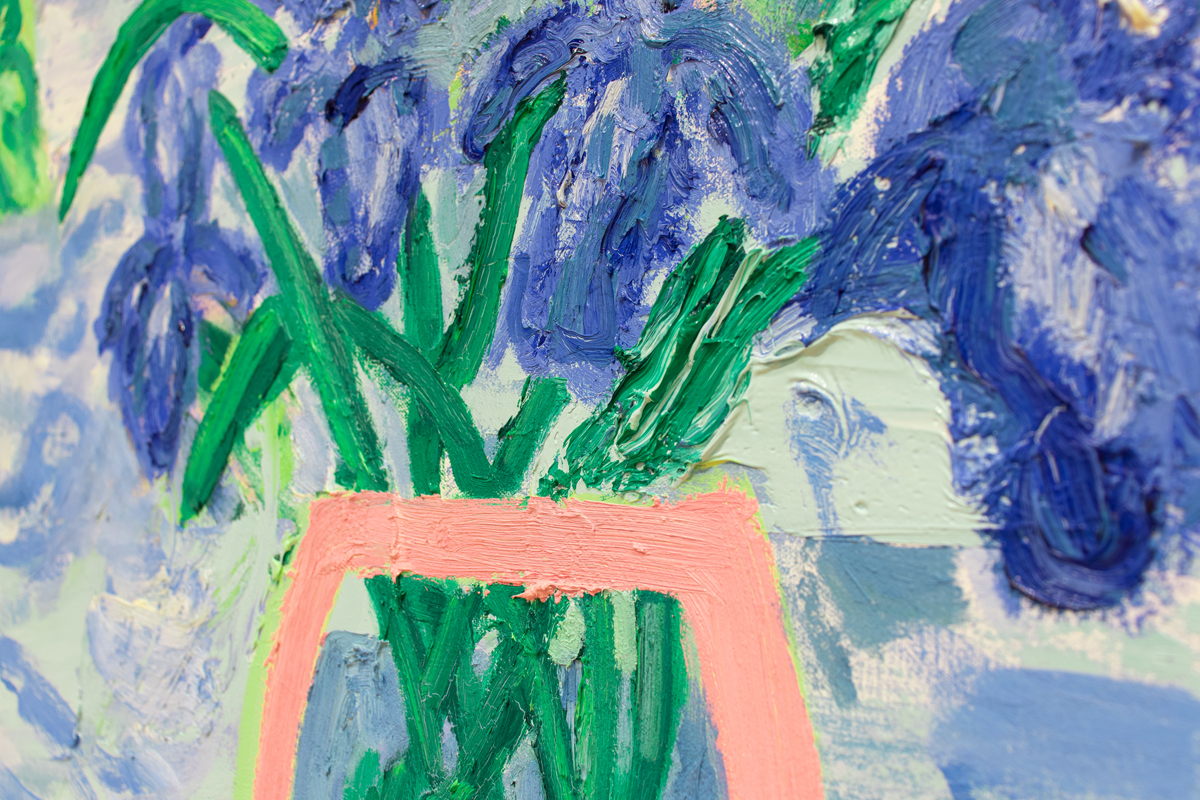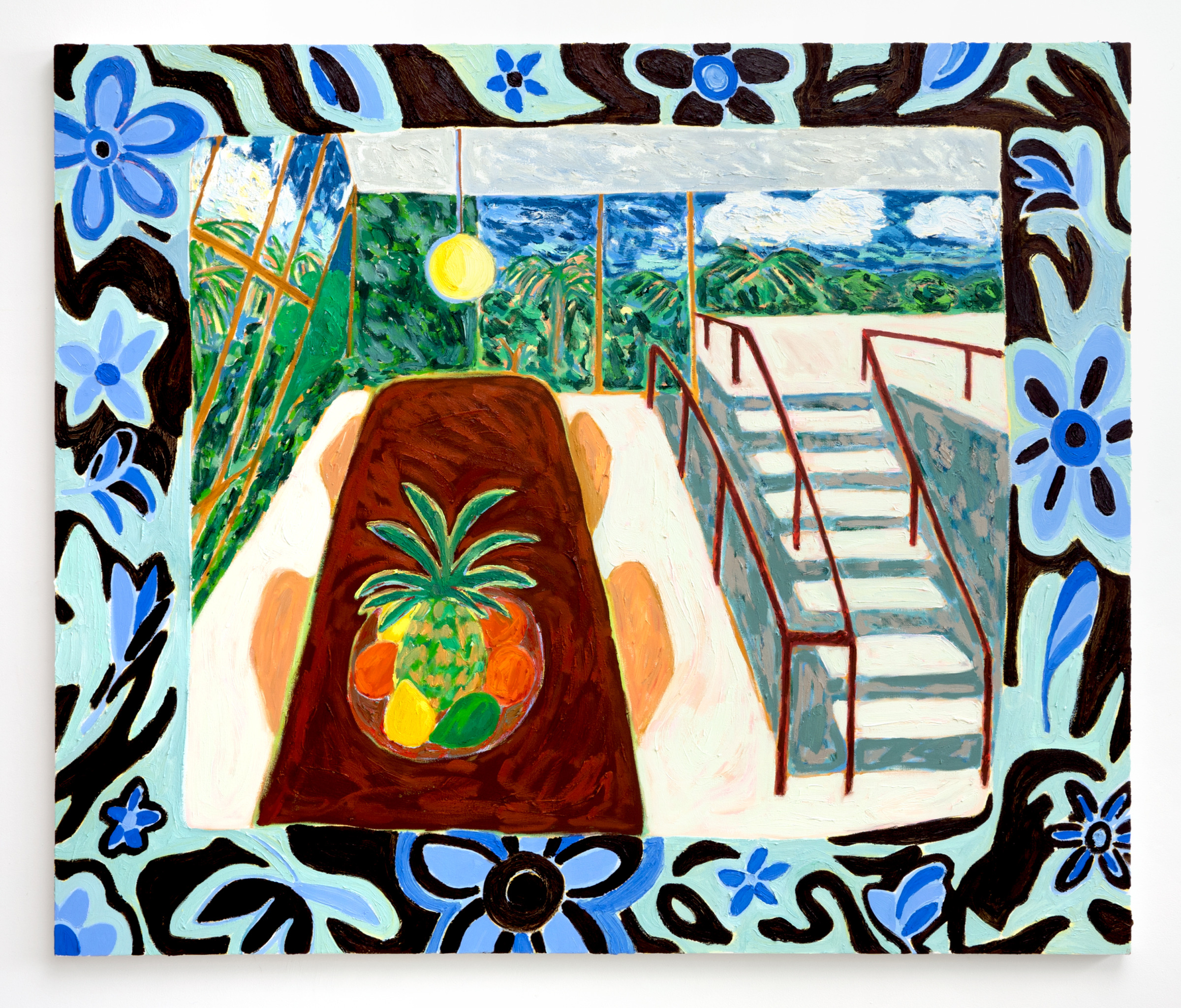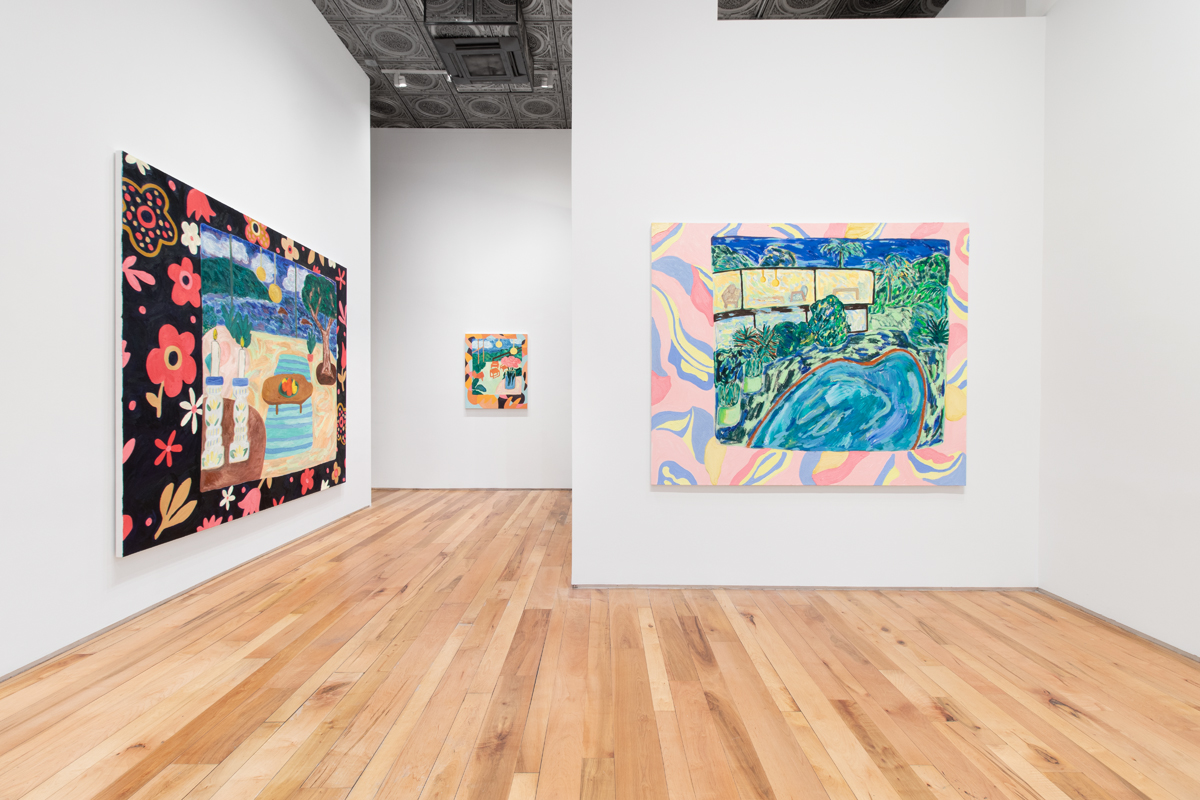Creating Worlds: Jessie Edelman Interviewed by Sara Roffino
Paintings that aim to facilitate daydreams.
Feb 21, 2022

Jessie Edelman, Irises, 2021, oil on canvas, 78 × 96 inches.
Look once and you see a beautiful landscape. Look longer and that landscape unfolds into a psychological state. And if you continue looking, you may find yourself within a story, perhaps your own, perhaps not. Or perhaps it’s the sort of story that is both your own and everyone else’s too—longing for something, searching, remembering the feeling but not quite the details of the space surrounding you. Jessie Edelman’s recent body of paintings, on view in Getaway at Dimin Gallery, have that ability to transport you back into your own mind. Culled from real and imagined places, Edelman’s landscapes unfurl as thoughtful meditations on time, self, and the relationship between the two. The works are as easy to get lost in as one’s own mind.
—Sara Roffino
Sara Roffino
I find myself thinking of your work in literary terms. Maybe this is because the figures you were previously depicting were somehow relatable to me in a personal way or there was some sense of something familiar. It seems, however, that there is a strong presence of character and narrative, though if these paintings had to be categorized, they would fall under landscape. Can you talk a bit about this idea of narrative and character? Does it resonate with you, or is that a projection I am bringing?
Jessie Edelman
Literature has always played a role in my life; I grew up with a librarian and have loved to read fiction from an early age. My paintings often incorporate a sense of narrative. I often think of them as stills from a movie, a sliver in time with a strong female lead. My current work very much focuses on place and world building.
SR
Your works are very simply beautiful with their luscious palettes and open space that lets the mind wander. There is no sense of trying to shock or teach, which is not to say at all that there is not deep thinking or conceptual underpinnings; it’s just that it’s done in a way that is unalienating for those who may not have a deep knowledge of painting. There is a true pleasure in looking at your work. Is this an intentional way of making? Who do you think of as your audience when you are making?
JE
I get so much joy out of looking at and making paintings. It has always been a place of escape and indulgent color. While I challenge myself to play with what a painting can be and its possibilities, I want it to be accessible to anyone. Painting and image-making is such a basic human language that we should be able to speak to anyone through it. Everyone understands a piece of fruit or the ocean.
Detail of Jessie Edelman, Irises, 2021, oil on canvas, 78 × 96 inches.
SR
Your earlier works always included a figure, but those figures no longer appear in the current show at Denny Dimin. What brought about this change?
JE
I stopped painting the figures around the beginning of the pandemic. I wanted to just focus on the space and think about architectural space and the juxtaposition between the inside and outside of the painting. I was becoming more interested in spatial relationships, and I wanted to open up more psychological breathing room. Once I did that it allowed for the viewer to have the same sort of experience my figures were having. I feel like the figures in my painting were daydreaming or contemplating and in a state of rest or not doing anything, and taking them out allowed for viewers to have that experience themselves.
Taking the figures out of the paintings also really changed the scale for me. I felt like suddenly these were objects I wanted to make bigger, and they’ve become personified. And I added the borders which came from a lot of different references—windows, fabric, mosaics, murals. There is a flattening of contemporary references: for example, Instagram and all these filters we are looking through and this sense of desire for a different space. But I think painting has always been that: the desire to go into another space.
SR
I just read this Rachel Cusk essay “Making Home,” and she says a lot of compelling things, one of which is that “like the body itself, a home is something both looked at and lived in.” This made me think about your work and the relationship between the figures and these domestic spaces.
JE
I like to paint spaces that I imagine people live in, particularly common spaces where people come together. There is a sense of home in the work and a fantasy of what it could be. I think the concept of the home in my work is more like a headspace or a feeling space than a body.
SR
You’ve also introduced these sort of retro-patterned borders, which create a tension with the painting. You can’t imagine the painting without them.
JE
I want the borders to feel like a different world. I try to keep the palette of the interior space different from the border. I’m not attached to the word border, but I do think of them as a different space, like an abstract space that is juxtaposed to the interior. And I do think there’s a tension between the two. I like to feel as if there’s an AbEx sort of push/pull between them, like in a Willem de Kooning painting. They are meant to elicit a feeling that uncannily relates to the interior.
Jessie Edelman, Pineapple, 2021, oil on canvas, 60 × 72 inches.
SR
The borders also create this idea of a painting of a painting in that the borders can function as a wall space.
JE
They play with perspective and point of view. The viewer is in more than one painting at once which I think creates some sort of duality of time and space. When we are present there is the physical reality around us and there is also the emotional reality of what is happening inside—your thoughts—and those are never the same. We don’t always have a sense of continuity of ourselves and where we are, and maybe these paintings are trying to express that we have this interior world and then we have the reality around us.
SR
They are also paintings that can become a double remove where if you’re looking at it as a painting of a painting you’re simultaneously having the experience that the person looking at the painting is having.
JE
That was very much expressed in my previous work where there was a figure looking into another space, and it felt like it was a doubling of a painting in a painting. These still do that. These really are paintings about painting, and I want the viewer to be aware that you are looking at a painting of a painting. If there wasn’t the border, you could maybe get lost in the illusion; but I think that because there’s this other painting around the painting, you have to question what is the is of this thing. What is this thing?
SR
It also makes you feel like you’re looking at someone else’s photograph or memory, almost in a voyeuristic way.
JE
The viewer is a voyeur into this world, peering into another space. Perhaps viewers can imagine themselves there. I’ve always been drawn to the post-Impressionists because I love that their spaces are so idealized. They are so wonderful, like a hyper-space, a hyper-world, if the world could be more colorful and fanciful. When I see those paintings I want to jump inside, and I think I wanted to take something from that.
We’re constantly presented with other people’s worlds on social media and perhaps now in the metaverse, but it is a fantasy of what people want to display; it’s not real.
Installation view of Jessie Edelman: Getaway.
SR
You talk a lot about creating worlds. Where does this come from?
JE
Through painting I am imagining places I would like to be, informed by collected images, memories, and sketches. A single painting feels like a whole world to me, and the culmination of the paintings creates a whole universe. I can transform my studio or a room into a fantastical other place through painting. Perhaps this comes back to narrative, but once I start painting a place I can imagine other rooms in that house, who lives there, what the garden looks like, the homes across the bay, the possibilities feel endless to me.
SR
Are your landscapes real places?
JE
The landscapes are imagined. They are an amalgamation of memories of places I have visited, collected images, and pure invention. I don’t think of them as real locations but places that feel familiar, like a place I have been but maybe in a dream, inviting and warm with rich greenery and blue sky and water. I hope the viewer ultimately feels like they are transported inside the painting.
Jessie Edelman: Getaway is on view at Dimin Gallery in New York City until February 26.
Sara Roffino is a writer and editor based in Brooklyn.




